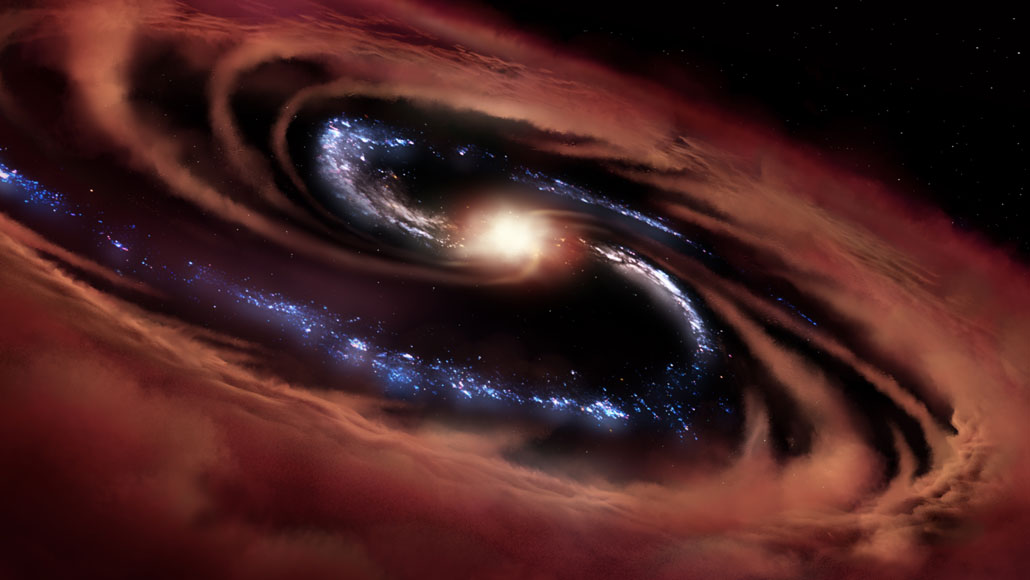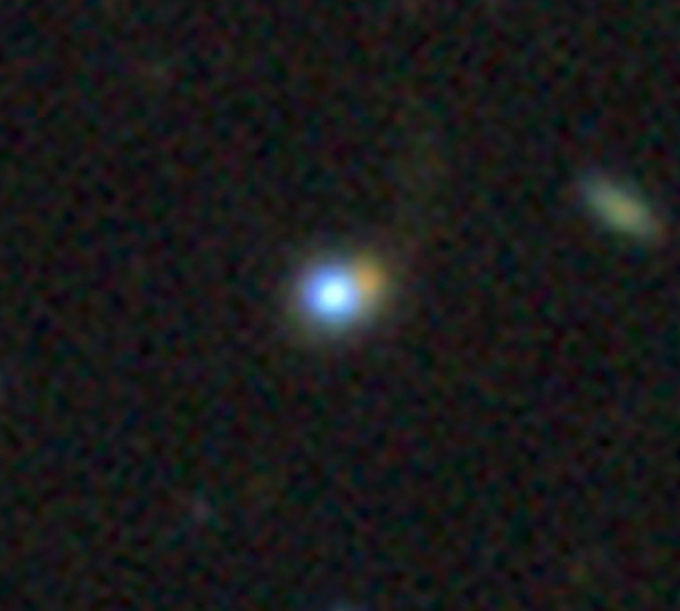
A cold quasar (illustrated) is a galaxy going through one last gasp of star formation as its central supermassive black hole wakes up. Within a few hundred million years, astronomers think that black hole will blow dust and gas out of the galaxy, shutting down star formation.
NASA, Daniel Rutter
- More than 2 years ago
A distant galaxy has been caught in the act of shutting down.
The galaxy, called CQ 4479, is still forming plenty of new stars. But it also has an actively feeding supermassive black hole at its center that will bring star formation to a halt within a few hundred million years, astronomers reported January 11 at the virtual meeting of the American Astronomical Society. Studying this galaxy and others like it will help astronomers figure out exactly how such shutdowns happen.
“How galaxies precisely die is an open question,” says astrophysicist Allison Kirkpatrick of the University of Kansas in Lawrence. “This could give us a lot of insight into that process.”
Astronomers think galaxies typically start out making new stars with a passion. The stars form from pockets of cold gas that contract under their own gravity and ignite thermonuclear fusion in their centers. But at some point, something disrupts the cold star-forming fuel and sends it toward the supermassive black hole at the galaxy’s core. That black hole gobbles the gas, heating it white-hot. An actively feeding black hole can be seen from billions of light-years away and is known as a quasar. Radiation from the hot gas pumps extra energy into the rest of the galaxy, blowing away or heating up the remaining gas until the star-forming factory closes for good (SN: 3/5/14).
That picture fits with the types of galaxies astronomers typically see in the universe: “blue and new” star formers, and “red and dead” dormant galaxies. But while examining data from large surveys of the sky, Kirkpatrick and colleagues noticed another type. The team found about two dozen galaxies that emit energetic X-rays characteristic of an actively gobbling black hole, but also shine in low-energy infrared light, revealing that there is still cold gas somewhere in the galaxies. Kirkpatrick and colleagues dubbed these galaxies “cold quasars” in a paper in the Sept. 1 Astrophysical Journal.
“When you see a black hole actively accreting material, you expect that star formation has already shut down,” says coauthor and astrophysicist Kevin Cooke, also of the University of Kansas, who presented the research at the meeting. “But cold quasars are in a weird time when the black hole in the center has just begun to feed.”
To investigate individual cold quasars in more detail, Kirkpatrick and Cooke used SOFIA, an airplane outfitted with a telescope that can see in a range of infrared wavelengths that the original cold quasar observations didn’t cover. SOFIA looked at CQ 4479, a cold quasar about 5.25 billion light-years away, in September 2019.
The observations showed that CQ 4479 has about 20 billion times the mass of the sun in stars, and it’s adding about 95 suns per year. (That’s a furious rate compared with the Milky Way; our home galaxy builds two or three solar masses of new stars per year.) CQ 4479’s central black hole is 24 million times as massive as the sun, and it’s growing at about 0.3 solar masses per year. In terms of percentage of their total mass, the stars and the black hole are growing at the same rate, Kirkpatrick says.

That sort of “lockstep evolution” runs counter to theories of how galaxies wax and wane. “You should have all your stars finish growing first, and then your black hole grows,” Kirkpatrick says. “This [galaxy] shows there’s a period that they actually do grow together.”
Cooke and colleagues estimated that in half a billion years, the galaxy will host 100 billion solar masses of stars, but its black hole will be passive and quiet. All the cold star-forming gas will have heated up or blown away.
The observations of CQ 4479 support the broad ideas of how galaxies die, says astronomer Alexandra Pope of the University of Massachusetts Amherst, who was not involved in the new work. Given that galaxies eventually switch off their star formation, it makes sense that there should be a period of transition. The findings are a “confirmation of this important phase in the evolution of galaxies,” she says. Taking a closer look at more cold quasars will help astronomers figure out just how quickly galaxies die.







